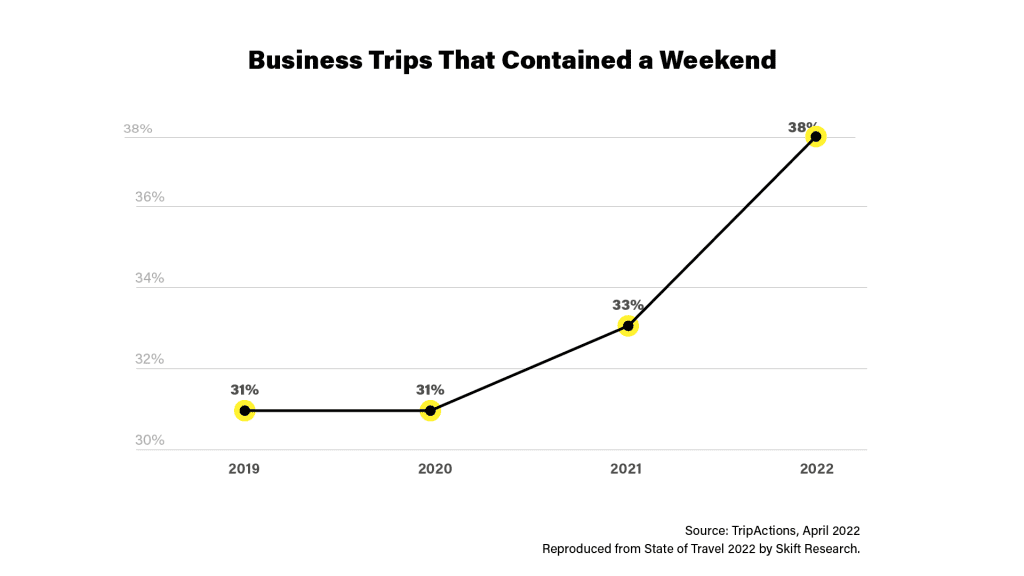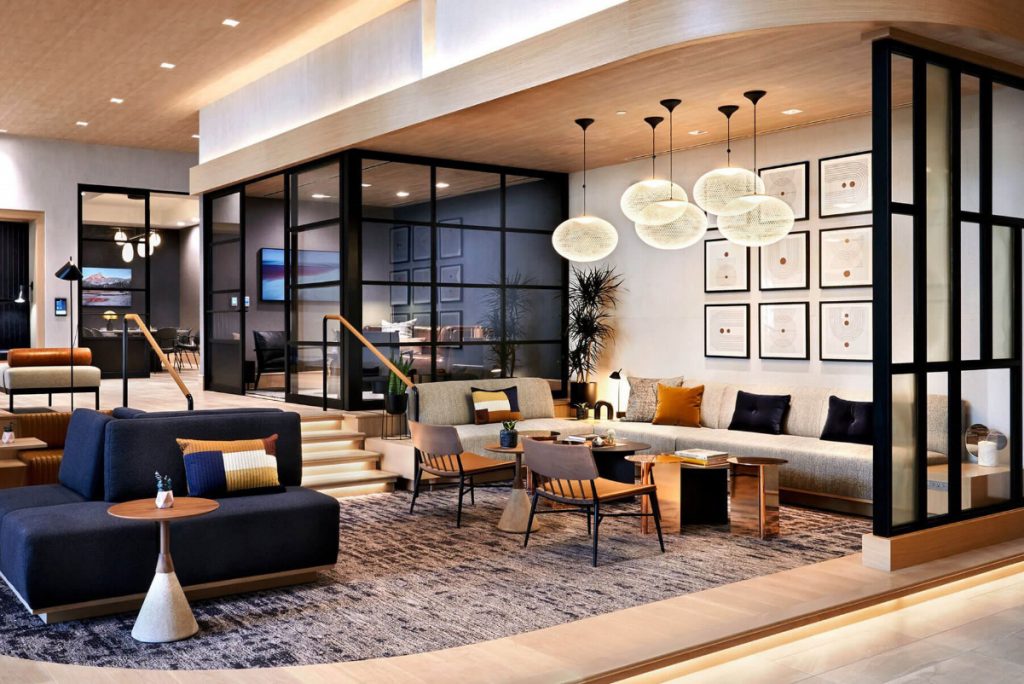Skift Take
The travel industry has acknowledged the pandemic led to a surge in people blending leisure with work. Now it’s got to figure out how to unravel the Great Merging to better serve this new and dynamic customer persona.

Megatrends 2023
Discover the top trends that will define the travel industry for the coming year.
The pandemic has led to a permanent change in how we live our lives between work and the personal. No longer just a trite category called “bleisure,” the idea of blended traveling is front and center for every major travel company now. How new strategies focused on the blended traveler will emerge more clearly in 2023, as the industry recognizes the whole traveler holistically.
Travel CEOs talk openly now on earnings calls about the opportunities and revenue gains from this blended traveling. While coronavirus opened up remote working to the masses, office and company travel policies still remain fluid.
Blended travelers are here to stay clearly, based on observations from leading execs at some of the biggest travel companies. Airlines and hotel groups have now recognized their importance, particularly as travel restrictions during 2022 were lifted and new trends emerged.
By The Numbers: Blended Travel Comes of Age
-
$497.5 Billion
Value of blended travel market in 2022
-
2 in 5
Number of employees requesting blended travel according to travel managers
Booking patterns are more “spread” out, for example, according to Robert Isom, CEO of American Airlines.
“We’re doing things differently. So as much as you’d like to say that you got to get all your work done Monday through Friday, people are spreading out. Not just 9:00 to 5:00, but going throughout the day, but then also the week as well,” he said at the recent Skift Aviation Forum. “It’s just you don’t need to have your holiday on a Saturday and Sunday. People are much more willing to do that at different times and also mix purposes of travel”
His comments came after the airline’s chief commercial officer Vasu Raja revealed in September that half its revenue now came from blended trips — a figure that has itself doubled — and it looks set to drive “real revenue growth.”
There’s also consensus the charge is being driven by small and medium sized businesses, who were first out of the doors compared to larger, more cautious, companies. And even today they’ll have fewer constraints, and are more likely to embrace work-from-anywhere policies.


Lifestyle Pushes
Hotel groups are cashing in. Accor expanded its co-working brand Wojo at the height of the pandemic. Marriott launched an extended-stay product called Apartments by Marriott Bonvoy, after the pandemic’s boom in remote and hybrid working styles generated demand for home-like amenities and experiences.
Lifestyle brands jumped in, taking the mix of business and leisure to new levels. Ennismore is so enamored with blended travelers it’s adding workspaces to its full portfolio. Developers are onboard as it increases the revenue mix.

Newer brands like Selina went public off the renewed interest, with the hospitality brand looking at corporate packages as well as digital nomads. And Airbnb (which listed during the pandemic) reports its fastest growing average length of stay is 28 days or more.
“The world is going towards remote work and I think anyone that doesn’t believe that is basically betting against where the entire trends are going,” said its CEO, Brian Chesky, at Skift Global Forum last summer.
Other components of the travel industry are also investing, from adventure tour operators to hostel booking platforms. Even WeWork is seeing a faster pace of growth for flexible membership subscriptions compared to its usual office space lettings.
The Technicalities of the Blended Traveler
Everyone has the blended traveler in their sight, but needs to find their niche.
The complexity of the challenge is reflected in Hilton’s recent student challenge. The group opened up an international competition for ideas on strategies to not only identify blended travelers, but find out exactly when and where the best opportunities exist in the customer journey to convert the “static” business or leisure traveler into a blended one.
We don’t know who the blended traveler is, because the spectrum is wide: remote workers, digital nomads, families, people booking workcations, or corporate retreats.
The problem is compounded by the fact they will mostly comprise people belonging to small and medium-sized companies, many of which won’t use a corporate travel agency.
Even revenue managers will struggle, as Tripbam’s David Mollov has pointed out traditional models will have a hard time catching up, because the hotel industry is generally slow to adopt new technology. “It used to be Tuesday and Wednesday were the sweet spot days. I don’t know if that will still be the case,” he said.
American Airlines’ Isom has also suggested more analysis of travelers’ spending behavior.
But Nelson Boyce, managing director of travel at Google, sums it up. He was quizzed on what marketers were doing to attract this lucrative traveler base at a recent industry conference. Are they easy to identify? Are strategies being employed to bring them in?
“To be honest, a lot of it remains to be seen,” he responded. “I can’t point necessarily to any particular marketer that is doing it well. It’s …. green shoots, open field as to what could come next.”
Google also saw a spike in searches for terms like Marriott Bonvoy and Hilton Honors in July, in combination with a lot of business travel. “It begs the question around the opportunity marketers may have: how do I continue to amplify my messaging around loyalty programs, knowing that there’s this traveler that may be doing a bit of both. How do I amplify different aspects, amenities, certain things about properties that makes that travel even easier to do,” he said.
This year will require a major overhaul in marketing strategies and loyalty programs. From cross-channel advertising and personalized content to commercial relationships with online travel agencies — so much needs rethinking in 2023 as travel brands track down the blended traveler.
Tags: blended travel, business travel, leisure travel, megatrends 2023

